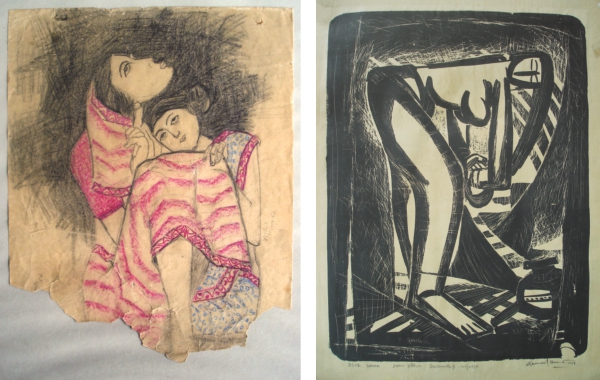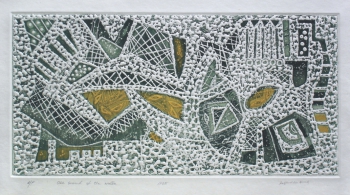| Home - Back Issues - The Team - Contact Us |
 |
| Volume 11 |Issue 45| November 16, 2012 | |
|
|
Art Of Colours, Composition and Creativity Fayza Haq
Muneeruzzaman, now, one of the directors of Chitrak, who had worked for decades for Faiz Ahmed's “Shilpangan,” earlier, left Potuakhali to be a painter, against the wish of his parents—who would rather that he were a conventional engineer, lawyer or doctor. But he is as much a lover of works by other artists as he is of painting himself. He takes great pride in his personal collection of Bangladeshi masters, including SM Sultan, Mohammed Kibria, Shafiuddin Ahmed, and others who taught him at the Dhaka College of Arts (now Institute of Fine Arts, Dhaka University). Muneer is also an admirer of Aminul Islam, and the younger Rafiqun Nabi. He hopes to have an exhibition of these works at “Chitrak”. Among the icons he admires is unsurprisingly Tagore. He says that Tagore taught the artists of Bengal all forms of art of that time, specially painting. The connoisseurs of Europe admired Tagore's work, as did people of the Far East, especially of Japan. Like the artists of the Bengal School of Art of the Colonial days, Muneer too admires folk art in the form of clay dolls, wooden elephants and horses on wheels, found in local fairs, like the “Shora”, which are on display – along with a massive crocodile and turtle—in Muneer's showcase in the living room – with its rattan chaise –lounges.
Right from the outset, from class one, Muneer was attracted to drawing and painting. He was also naturally influenced by nature and its beauty such as the flowers, birds, clouds, grass and waves of the rivulets. What he saw, he tried to imitate from magazines and art books in the Art College in Dhaka. He was from the 1977 batch. He did his Masters in 1985. His classmates included Shishir Bhattachrjee, Mrinal Haq, and Morsheda Arzoo Alpana—now often operating from Germany, and who recently had a work on the clean waters of the waterways of Dhaka at the Goethe Institute. Angalun Rehman and Abdur Rauf—but they have drifted away. Today one hears only of Shishir and Mrinal Haq in the art world. Muneer's teachers were Shahid Kabir and Mahbubul Amin(in the pre-degree). Later he had Rafiqun Nabi and Kazi Abul Basset,and Aminul Islam. As for books on art, they were read in the Art College in Dhaka. At the same time, Muneer was fascinated by the Calcutta Art School. Although he now runs a gallery, it is to be a true artist in mind and soul that he craves after. He says that he likes doing watercolour and as subjects he likes to draw his inspiration form Nature as did Matisse, Pissaro, Renoir and other French Impressionists. But of course, he is also an admirer of the Spanish Italian Renaissance artists, like Botticelli, Michelangelo. Leonardo de Vinci, Giotto, Rubens, Goya and such like. Muneer loves the old masters and adores the 19th century French painters. He goes in for the semi-abstract. As for landscape, he wishes to place man against nature. For him the “homeless”, “refugee” as subjects are dear to him. The common man is of all importance to him. Dedicated teachers like Rafiqun Nabi, with his woodcut print and water colour have influenced him greatly. His composition, colour and simplicity have made a mark on most young artist's mind and style.
Asked if the art market tends to dictate the artists whom they patronise, Muneer says the collection is from a good hobby; some wish to promote the scenes of Bangladesh in their living room. There are also the rich industrialist, bankers who commission the artist. Here the artist finds his creativity being diminished. “Factory-made” paintings also have their demand in certain places, and are not necessarily derided, says the artist. The art outlets promotes contemporary artist for the art lover. An artist has a message of his own—which is in keeping with the socio- economic and political surrounding. The manner in which the artist expresses himself on the canvas is a matter of the artist alone, and the buyer should not dictate him. If and when the painter puts his soul and mind on the canvas or paper, the resulting work of painting is bound to be fine, says Muneer, who is well-known as a “Chitrak” director. The artist is fond of folk art—apart from the influence for the Italian Renaissance and Impressionist painters of the west, which includes Venice and Italy—where some of our own painters have been, and have obtained their training, like Murtaja Baseer and Aminul Islam. He hopes to promote folk art, with items like carved wooden crocodiles, turtles etc apart from dolls and wooden animals on wheels— which are to be found in the fairs of the local villages. "Line, dots, curves, colour, composition, and theme go hand in hand in making a successful painting,” says Muneer.
|
||||||||||||
|



